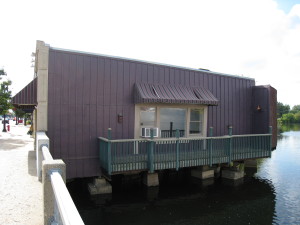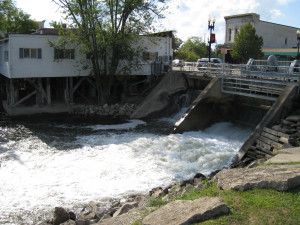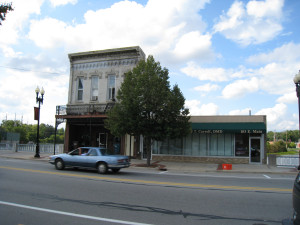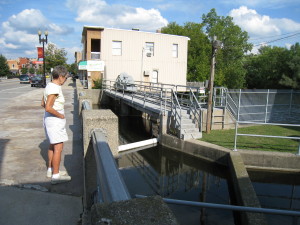By Joel Thurtell
LOWELL, Mich. — It doesn’t attract as many tourists as Italy’s Ponte Vecchio, but Lowell’s Main Street Bridge bears a certain similarity to that 14th-century pedestrian span over the Arno River in Florence.
Lowell’s bridge, barely 100 years old (remember, folks, I wrote this story in 1979!), not only links separate halves of the Kent County town but serves as a retail district for its 3,000 residents.
The Ponte Vecchio is lined with small stalls specializing in jewelry and souvenirs, while the Lowell structure supports two barbershops, a dress boutique, a television store and an auto-parts outlet.

This building facing Lowell’s Main Street is built on pilings that support it over the Flat River. In the 1930’s, it housed my grandfather Martin Houseman’s meat market. In winter, my Uncle Charlie Houseman used to walk from the store to school over the ice. This building now is part of the Main Street Inn.Photo by Joel Thurtell 9-5-2008.
A visitor intent on window-shopping here might not even notice that M-21, Lowell’s main artery, crosses the Flat River 15 miles east of Grand Rapids. Facing the bridge, the stores extend north and south from Main Street and are supported by concrete and wood pilings planted in the river bottom.
Although a central location is important to merchants anywhere, it is difficult to understand why Lowell’s pioneers erected shops over water, unless perhaps they anticipated a fire and wanted a ready source of water. That hasn’t always been helpful, however.
An early wooden span was swept by fire in 1904. Shops were rebuilt in the same locations, but a year later the Grand River backed up over a wide region of western Michigan and forced tributaries such as the Flat to rise so forcibly that sections of the bridge were torn away. Historians cannot determine why Lowell’s elders constructed stores along the bridge in the first place, then rebuilt there after two disasters.

Lowell’s Main Street dam is on the right. The building on pilings once was the site of my grandmother Harriet Thurtell’s dress shop. Photo by Joel Thurtell 9-5-2008.
One explanation is that in the 1880’s real estate prices were relatively high, so some merchants chose sites where they would not need land titles. Another guess goes like this: In the mid-19th century the Flat River was a narrow, shallow, fast-running stream, but just before the Civil War grain millers began damming it for a source of power. One dam went in where the bridge now stands (and a successor mill remains there). As the water level rose, shopkeepers who had built close to the embankment faced gradual flooding and either moved their stores or put pilings under the buildings.
Despite all the water below, a big mill was gutted by fire in 1943. In 1958, six stores and a tavern burned out. Nor is fire the only hazard.
In 1955, old pilings under the Kroger store collapsed from rot and caused the entire sugar stock to float away in the Flat.

Two stores remain where once a row of stores extended from the east to the west banks of the Flat River. Fire destroyed several stress on the right, and emotion took buildings on the left. A few stories remain on pilings. Photo by Joel Thurtell 9-5-2008.
Some shops could become a nuisance to the millers, too. At the turn of the (20th) century, the owner of a produce store sold bananas picked from tough, many-branched stems. When these were empty, he tossed them out a back window into the river, forcing a nearby mill to open its dam, lower the river and remove the debris from turbine machinery every few weeks.
Norton Avery, who operated a photographic studio on the bridge before World War I, recalls sending an assistant to the front door to make sure no horse-drawn carriages were approaching when he was about to make portraits. The vibration of buggies on the plank roadway of that era caused his equipment to tremble and could ruin his pictures, he said.
Now 85, Avery (again, recall I wrote this in 1979; Norton Avery is either very old or very dead) saw his former shop razed recently, after its roof began sagging away from an adjacent building toward the river.
But enough others survive to make a trip to Lowell an interesting diversion for tourists.
Drop me a line at joelthurtell(at)gmail.com
